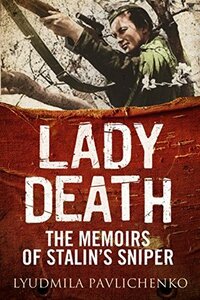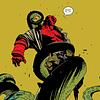You need to sign in or sign up before continuing.
Take a photo of a barcode or cover
35 reviews for:
Lady Death: The Memoirs of Stalin's Sniper
Foreword by Martin Pegler, Lyudmila Pavlichenko
35 reviews for:
Lady Death: The Memoirs of Stalin's Sniper
Foreword by Martin Pegler, Lyudmila Pavlichenko
informative
slow-paced
informative
slow-paced
informative
tense
medium-paced
Graphic: Violence, War
Moderate: Suicide
Minor: Rape, Sexism
If you want to hear a woman say, “Every fascist must meet death” quite a few times, this book (and audiobook) are for you! I am not generally a fan of military history, but this story is gripping. It is also very interesting to compare the history of my country (USA) to Russian history. Of course the author wanted to show Stalin’s Russia in a good light, but as she comments on segregation and the American journalists’ preoccupation with her femininity, we can see that US exceptionalism is a myth.
informative
I am convinced Lyudmila Pavlichenko and Eleanor Roosevelt had a queer fling after this. Calling her "my darling" exclusively, sleeping on Eleanor's shoulder, staying in hotels together across the country, FOREHEAD KISSES. It's not my biggest takeaway but it was definitely the hot take I was NOT expecting to find.
It was also a beautiful and brutal account of being an incredibly accurate female sniper for the Soviet Union. All in all, a great read. Lydumila was a badass and I want to paint her likeness.
It was also a beautiful and brutal account of being an incredibly accurate female sniper for the Soviet Union. All in all, a great read. Lydumila was a badass and I want to paint her likeness.
adventurous
challenging
dark
informative
inspiring
reflective
slow-paced
I recently read a book (“The Diamond Eye”, Kate Quinn, March 2022) which is a fictional novel featuring Lyudmila Pavlichenko. I was fascinated by the premise of a female sniper in WWII so I went looking for this book which served as an inspiration for Quinn’s novel.
“A classic was once defined as a book you remember starting to read but you never stop reading or re-reading. This is such a book.” [Goodreads review, Willy Marz Thiessam, 01-25-2018]
In reviewing the reviews of this book, I was taken by this text from another reader’s review comments. It fits my personal definition of a “classic” better than any other definition. And this book is definitely a fit.
Lyudmila (“Mila”) was a University student working on her dissertation in History when Germany attacked Russia through Ukraine. She was the daughter of a communist party official and grew up as a pretty, privileged young woman. As part of her school sports activities, she got her first marksmanship training, winning all of the prizes and certificates available. So when she decided to enlist she was already a skilled shooter and with a couple of months’ training, she became a deadly sniper. Mila then describes her development as a sniper. During this time, she is wounded multiple times, completes 309 verified kills, receives the highest decorations for an infantry member, designed a program and then trained hundreds of snipers during the latter part of the War. In 1942-43, Mila made “good will” tours to a number of Allied countries including Britain, Canada and the U.S., usually in connection with some youth or young adult conference or sponspored event for international relations or working for peace. A major goal of these trips was to impress on the Allies that Russia was fighting the Nazis alone on the Eastern Front since mid-1941 and had lost men, resources and was the only thing keeping Hitler’s attention of away from full concentration on Central and Western Europe. On her trip to the US, she became friends with Eleanor Roosevelt who remained a pen pal years after she left the White. House. Due to Mila’s excellent language skills, she was also able to establish personal relations with others including Clementine Churchill who provided equipment to start a number of hospitals in Russia for casualties of war. After the War, Mila returned to her University education completing a degree in history from Kyiv University. But she was suffering greatly from her wounds and shell shock only living to 58.
An interesting historical side note is that Russia was the only Allied country in which women routinely served in the military forces including in combat positions. Women initially served in administrative or auxiliary positions. However, after Operation Barbarosa, Russia had such massive military losses that they had to rethink how to continue defending the country from the Nazis. From June, 1941 to the end of the War, more than 800,000 women served in the military (5% of all forces). Although many continued in support roles, there were great numbers in postings such as paramedics (40%), doctors (46%), surgeons (45%), medical assistants (57%) and nurses (100%). But there was a significant number of combat pilots, snipers, machine gunners, tank crew members and partisan resisters. After the War, most women left the military and attitudes and roles returned to more pre-War Norms. I found one estimate of the current Russian Armed Forces Ground Force is ~350,ooo and women make up about 10% or 35,000. Interesting……
challenging
informative
slow-paced
adventurous
hopeful
informative
inspiring
fast-paced
Major Lyudmila Pavlichenko was a Red Army sniper during World War II who attained 309 (!) kills in combat. This book details her transformation from a factory worker in Ukraine to one of the deadliest snipers in history.
It's a brilliant read, with chapters detailing her first 100 kills against the Romanians and then moving on to the German army. Her attention to detail with weapons is amazing - I often read memoirs where former soldiers just generally describe their guns as "tommy guns" or "machine guns" but Major Pavlichenko always details the full name of whichever weapon she is talking about, and also throws in some technical specs. The most interesting parts for me were the chapters in which she details a counter-sniping operation against a German sniper, and the chapters dealing with her speaking tour of the US and UK. It was interesting to note the attitudes of pre-war USA towards this woman, with reporters seeming to care more about the cut of her uniform and which colour of underwear she preferred rather than actually asking this soldier about life at war.
Definitely one of the best war memoirs I've read regarding the Eastern Front of WWII, and well worth a read to anyone interested in snipers or World War II in general.
It's a brilliant read, with chapters detailing her first 100 kills against the Romanians and then moving on to the German army. Her attention to detail with weapons is amazing - I often read memoirs where former soldiers just generally describe their guns as "tommy guns" or "machine guns" but Major Pavlichenko always details the full name of whichever weapon she is talking about, and also throws in some technical specs. The most interesting parts for me were the chapters in which she details a counter-sniping operation against a German sniper, and the chapters dealing with her speaking tour of the US and UK. It was interesting to note the attitudes of pre-war USA towards this woman, with reporters seeming to care more about the cut of her uniform and which colour of underwear she preferred rather than actually asking this soldier about life at war.
Definitely one of the best war memoirs I've read regarding the Eastern Front of WWII, and well worth a read to anyone interested in snipers or World War II in general.



